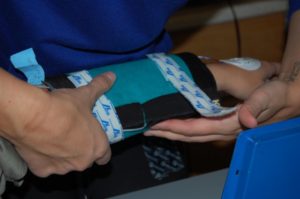
Scientists from the U.S. Army Research Institute of Environmental Medicine (USARIEM) are developing a new device, the Personal Heating Dexterity Device (PhD2) for warming hands and fingers in cold weather without the help of gloves.
The problem with working in freezing temperatures is the inevitable trade-off: either warm hands or dexterous fingers, but both has been nearly impossible. For soldiers, the loss of hand function in the cold can impact performance and even a soldier’s ability to survive, according to Dr. John Castellani, the principal investigator.
“One of the biggest issues for Soldiers operating in a cold environment is the loss of hand function and dexterity,” Castellani said. “Thick gloves can reduce Soldiers’ touch sensation and can decrease fine-motor dexterity by 50 to 75 percent. As a result, Soldiers tend to remove their gloves when they need to use their fingers. Unfortunately, this causes blood flow to decrease in the hands, impairing movement. This is a primary concern because hand function and dexterity are important for many tasks, such as loading ammunition, handling equipment and technology and treating injured Soldiers.”
Castellani, a research physiologist, added that researchers have spent the past 80 years developing technology for different parts of the body, in an effort to increase blood flow in the hands without obstructing hand movement. Researchers have successfully developed warming devices for the torso, but the technology has not been practical for operations. USARIEM researchers set out to create something small and unobtrusive for a Soldier on the move.
“We want to see if there is a way to improve hand dexterity in a cold environment that does not involve covering the hands and fingers,” Castellani said. “In our study, we focused on warming the forearms and face.”
Castellani’s team reasoned that by increasing blood flow just above the hand, some of that warmth would travel to the fingers. The team also focused on warming the face because previous research had suggested there were nerves in the cheeks and forehead that, when they got cold, caused blood flow to decrease in the hands.
USARIEM researchers developed prototypes of forearm and facial warming devices, which resembled heating pads, to test on eight research volunteers. They measured volunteers’ hand dexterity and finger strength before, during and after the cold exposure by having volunteers load ammunition into an M16 cartridge and take the Purdue Pegboard Test, which involved picking up and moving small pegs into sockets.
“We found that just heating the forearms worked,” Castellani said. “Heating the face by itself was not effective, and heating the face and forearms together was not a significant improvement. We also found that turning on the device after the fingers had cooled significantly was just as effective as keeping it on the entire time.”
The research team is now working with the Medical Support Systems and Evacuation Project Management Office in the U.S. Army Medical Materiel Development Agency, or USAMMDA, to advance the prototype of the patent-pending PhD2, making the device more portable and user-friendly for the uniforms of the future.
“Maintaining dexterity is so important for many occupations,” Castellani said. “When people think of cold weather, they usually concentrate on the worst-case scenarios, like hypothermia, which is life-threatening, and frostbite, which is debilitating and can cause life-long issues. But in order to have lethal Soldiers who can complete their missions, they have to be able to use their hands.”
DISCLAIMER: The opinions or assertions contained herein are the private views of the
author(s) and are not to be construed as official or as reflecting the views of the Army or the Department of Defense.
 TEXTILES.ORG
TEXTILES.ORG


